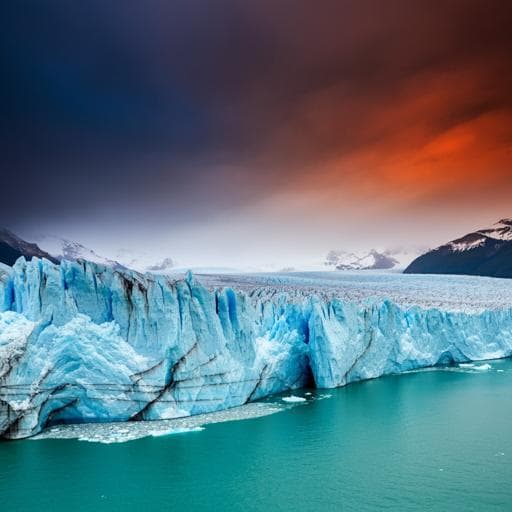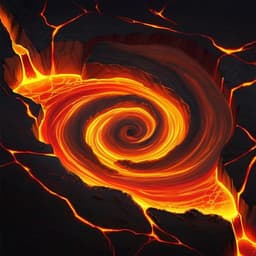
Earth Sciences
Return to rapid ice loss in Greenland and record loss in 2019 detected by the GRACE-FO satellites
I. Sasgen, B. Wouters, et al.
Greenland's ice loss has surged to alarming levels, reaching a staggering 532 ± 58 Gt yr⁻¹ in 2019, eclipsing even the notorious 2012 record. This study, conducted by Ingo Sasgen, Bert Wouters, Alex S. Gardner, Michalea D. King, Marco Tedesco, Felix W. Landerer, Christoph Dahle, Himanshu Save, and Xavier Fettweis, sheds light on the recent fluctuations in melt rates and their implications for global sea level rise.
~3 min • Beginner • English
Introduction
The study investigates how the Greenland Ice Sheet’s mass balance evolved during and after the transition from the original GRACE mission (ended June 2017) to the GRACE-FO mission (launched May 2018). The core research questions are: Did the apparent slowdown in mass loss during 2017–2018 persist, and what were the driving mechanisms? How did 2019 compare with previous extreme melt years? Contextually, the GrIS has increasingly contributed to global sea-level rise since the mid-1990s through enhanced surface melt and increased ice discharge. Atmospheric circulation anomalies (e.g., Greenland blocking) and Arctic amplification have been linked to interannual variability in melt. The purpose of this work is to use GRACE-FO gravimetry, combined with regional climate models (RCMs) and discharge data, to quantify recent mass changes, attribute them to surface mass balance components versus dynamic discharge, and relate them to synoptic atmospheric patterns. The findings are significant for understanding near-term variability and long-term trends in GrIS mass loss under Arctic warming.
Literature Review
Prior studies have established that the GrIS contributed 0.76 ± 0.1 mm yr−1 to global mean sea-level rise between 2005 and 2017, comparable to all global glaciers. Mass loss since the 1990s stems roughly two-thirds from increased surface melt (reducing SMB) and one-third from enhanced ice discharge. GRACE-era observations (2003–2016) showed accelerated mass loss up to 2012, associated with increased glacier flow and surface melting, and linked to more frequent anticyclonic summer circulation (Greenland blocking) that advects warm air and enhances melt-albedo feedbacks. Extreme melt years (2010, 2012) coincided with persistent high-pressure anomalies. Conversely, pauses or slowdowns (e.g., 2013) have been attributed to opposite synoptic patterns. The IMBIE synthesis and other multi-sensor studies converged on an average GrIS mass loss of −148 ± 13 Gt yr−1 from 1992 to 2018, with total losses exceeding snowfall since the early 2000s. RCMs such as MAR and RACMO have been widely used to quantify SMB and its components, while discharge time series derived from feature tracking and DEM differencing constrain dynamic outflow. Uncertainties remain in GRACE processing choices (e.g., low-degree replacements), GIA corrections, and model biases, necessitating combined observational–model approaches.
Methodology
Data: The study uses 180 monthly gravity field solutions from GRACE (April 2002–June 2017; 163 months) and GRACE-FO (June 2018–December 2019; 17 months), Release 06 Level-2 Stokes coefficients from GFZ, CSR, and JPL SDS centers. Common corrections include insertion of degree-1 terms (per SDS Technical Note 13), replacement of C20 with SLR estimates (Technical Note 14), and a glacial isostatic adjustment (GIA) correction using model GGG1.D (+16 Gt yr−1 equivalent over Greenland; uncertainty ±17 Gt yr−1 considered in trend/annual estimates). The study does not replace C30 with SLR due to potential discontinuities.
Combination and uncertainties: A combined monthly solution (AV RL06) is formed by coefficient-wise weighting across SDS centers, using calibrated uncertainties derived from residual degree power in degrees/orders 40–60. Trends are removed prior to combination and restored with equal weights to avoid artificial variability. Monthly uncertainties are scaled from global residual degree power to the GrIS residual mass variability, acknowledging higher polar sensitivity and including a ±25–26 Gt monthly inversion uncertainty.
Gravimetric inversion: Mass anomalies over the GrIS are retrieved via forward modeling inversion with low-frequency damping, a non-uniform a priori mass distribution, and seven drainage basins (plus Ellesmere Island to mitigate leakage). Basin-scale gravity signals are filtered consistently with GRACE/GRACE-FO and fitted by least squares to observed fields. Estimated monthly inversion uncertainty is ±25 Gt.
SMB and discharge: Surface mass balance (SMB) and components come from MAR v3.10 (20 km; forced by NCEP–NCARv1; 1948–2019) and RACMO2.3p2 (downscaled to 1 km from 5.5 km; forced by ERA reanalyses; 1958–Aug 2019). SMB components include net accumulation (snowfall minus evaporation/sublimation) and meltwater runoff (melt production minus refreezing/retention). SMB uncertainties are about ±22 Gt for detrended totals; individual components may have compensating biases. Dynamic ice discharge (D) uses temporally extended, monthly-to-subannual glacier-scale records (N>200 wide outlets) from feature tracking and elevation differencing (ASTER, SPOT-5, ArcticDEM; Landsat, RADARSAT, TerraSAR/TanDEM-X), with Kalman-filter gap-filling; 2σ uncertainty ~10–20 Gt yr−1. The net mass balance proxy SMB−D is adjusted by a linear trend correction to reconcile with GRACE/GRACE-FO over 2003–2019 (e.g., −7 Gt yr−1 for RACMO2.3p2; +52 Gt yr−1 for MAR v3.10 with NCEP).
Time series analysis: Mass time series are modeled with piecewise linear functions to estimate biennial mass balances (breaks on Jan 1 of alternating years; windows centered on peak summer loss) to bridge the 2017–2018 observational gap. Monthly mass fluxes for 2019 are computed as central differences of cumulative mass anomalies (GRACE-FO and SMB−D*), compared to the 2003–2016 GRACE climatology. Statistical significance is assessed at the 5% level for biennial losses.
Key Findings
- The 2017–2018 biennial period exhibited a 58% slowdown in GrIS mass loss relative to the 2003–2018 average, with an average rate of −98 ± 29 Gt yr−1 (abstract; −98 ± 26 Gt yr−1 in results). All biennial balances from 2003–2018 nonetheless indicate statistically significant losses at the 5% level.
- The average biennial mass balance over 2003–2019 is −235 ± 29 Gt yr−1; peak biennial loss was −437 ± 26 Gt yr−1 in 2011–2012.
- The 2017–2018 positive anomaly (+137 ± 25 Gt yr−1 relative to 2003–2018 mean) was driven approximately equally by enhanced snowfall (east) and reduced meltwater runoff (west).
- GRACE-FO monthly data show July 2019 mass change of −223 ± 12 Gt month−1 (abstract), the second-most negative July on record after 2012 (−234 ± 35 Gt month−1), followed by 2010 (−181 ± 27 Gt month−1). Minimum July loss observed by GRACE was −104 ± 23 Gt month−1 in 2014.
- The 2019 annual mass balance was a record −532 ± 58 Gt yr−1 (Jan–Dec), 15% more negative than 2012 (−464 ± 62 Gt yr−1). SMB−D* indicates similar meltwater runoff + discharge in 2012 and 2019 (−707 vs −693 Gt yr−1), but 2019 had 107 Gt yr−1 less accumulation than 2012.
- The abrupt transition from reduced loss in 2017–2018 to extreme loss in 2019 corresponds to a shift from cyclonic (low-pressure) to anticyclonic (blocking) summer circulation, confirming strong atmospheric control on interannual variability.
Discussion
The findings link interannual variability in GrIS mass balance to synoptic atmospheric circulation anomalies superimposed on a long-term warming trend. In 2017–2018, intensified summer cyclonic circulation over Greenland advected colder Arctic air southward along the west coast, suppressing melt and contributing to higher SMB via enhanced snowfall in the east, producing the observed slowdown in mass loss. In 2019, persistent anticyclonic conditions (Greenland blocking) reversed the pattern, advecting warm, dry mid-latitude air into western Greenland, enhancing melt-albedo feedbacks and reducing accumulation, culminating in record annual loss. Despite the brief slowdown, the trajectory since the late 1990s remains one of increasing net losses, with five largest loss years occurring in the last decade (2019, 2012, 2010, 2011, 2016). These results underscore the sensitivity of the GrIS to atmospheric dynamics and Arctic amplification and highlight the need to represent circulation-driven variability and surface feedbacks in projections of sea-level rise.
Conclusion
Using GRACE-FO continuity with GRACE, combined with RCM-derived SMB and observed discharge, the study quantifies a rare, short-lived slowdown in GrIS mass loss during 2017–2018 followed by an exceptional 2019 melt season that set a new annual loss record. The work attributes the slowdown and subsequent acceleration to opposing atmospheric circulation regimes and documents that recent extremes align with a continuing trend of increasing mass loss under Arctic warming. Continued satellite gravimetry, high-resolution SMB modeling, and improved characterization of atmospheric drivers are essential to better constrain interannual variability and to refine projections of Greenland’s contribution to sea-level rise. Future research should reduce GIA and low-degree coefficient uncertainties, reconcile SMB model biases, refine discharge estimates, and improve coupled ice–atmosphere–ocean representations of circulation and feedbacks.
Limitations
- Data gaps and instrument issues: GRACE ceased operations in June 2017 and late-2017 gravity fields have higher uncertainty due to accelerometer failure, creating a gap bridged by GRACE-FO starting mid-2018.
- GRACE/GRACE-FO processing choices: Uncertainty in low-degree coefficients (e.g., C20 replacement adopted; C30 replacement not used to avoid discontinuities), mission-specific processing differences across SDS centers, and combination weighting choices can affect trends and variability.
- GIA correction: The applied GGG1.D model contributes an uncertainty of roughly ±17 Gt yr−1 to annual and long-term trends, with published GIA corrections spanning −28 to +27 Gt yr−1 over Greenland.
- Spatial resolution and inversion: GRACE sensitivity (>~300 km) necessitates basin-scale inversion with assumptions on a priori mass distribution and filtering; monthly inversion uncertainty ~±25–26 Gt.
- SMB and discharge models: SMB uncertainties for detrended totals are ~±22 Gt, with potential compensating errors among components and possible mean/trend biases. Discharge uncertainty is ~10–20 Gt yr−1 (2σ). A linear trend correction was applied to SMB−D to reconcile with GRACE/GRACE-FO.
- Time-derivative smoothing: Central-difference calculation for monthly fluxes acts as a smoothing filter that can modestly reduce peak amplitudes compared to raw monthly model outputs.
Related Publications
Explore these studies to deepen your understanding of the subject.







